The 2018 Apple iPad Pro (11-Inch) Review: Doubling Down On Performance
by Brett Howse & Andrei Frumusanu on December 4, 2018 10:00 AM ESTThe Liquid Retina Display
Apple offers some of the best displays on the market, and the iPad Pro is arguably their best display available. What Apple calls a Liquid Retina display is a 264 pixel-per-inch masterpiece. The 11-inch model we are reviewing holds a 2388x1668 7:5 aspect ratio panel, while the larger 12.9-inch model uses a 4:3 2732x2048 panel.
There’s a lot that sets Apple apart from other manufacturers on the market. The company has taken display accuracy seriously longer than anyone outside of the professional field. The display in the iPad Pro is also a P3 D65 gamut display, but thanks to the color management system that Apple moved over from the Mac, it simultaneous offers near-perfect sRGB reproduction as well as near-perfect P3 reproduction whenever an app or image specifically says it's P3. There’s no compromise on offering the P3, and no need to change the gamut on the display to match different color spaces. It’s a P3 display where sRGB is properly mapped.
In addition, Apple’s iPad Pro offers their ProMotion technology, which means it is a 120 Hz display, but one that supports variable refresh rates in order to lower the display's refresh rate for power management purposes. The iPad Pro will go as low as 24 Hz, presumably chosen to match the framerate of most movies. Apple also carries over its True Tone functionality, where ambient light sensors change the white point of the display to make it more suited to the environment it is in. It’s one of those features you never really knew you needed until you see it in action.
The fully laminated display also offers Apple’s industry leading antireflective coating, which Apple rates at 1.8% reflectivity, improving the results outdoors dramatically over most devices, and of course there is a fingerprint-resistant oleophobic coating as well.
Apple rates the latest iPads at up to 600 nits of brightness too, so pretty much no matter where you are, the combination of the high brightness and the antireflective coating should make for a great viewing experience.
To test the display characteristics, we turn to SpectraCal’s CalMAN software suite, along with an X-Rite i1Display Pro colorimeter for brightness and contrast readings, and the X-Rite i1Pro 2 spectrophotometer for color accuracy readings.
Brightness and Contrast
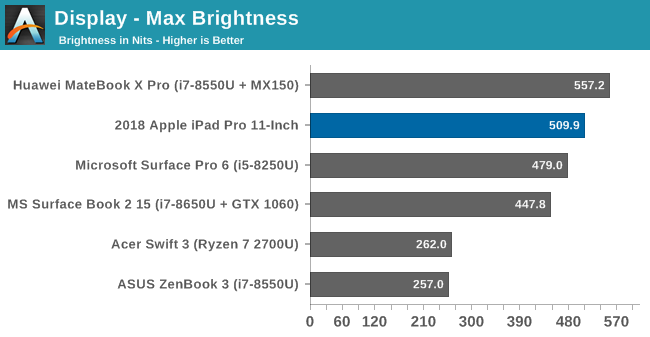
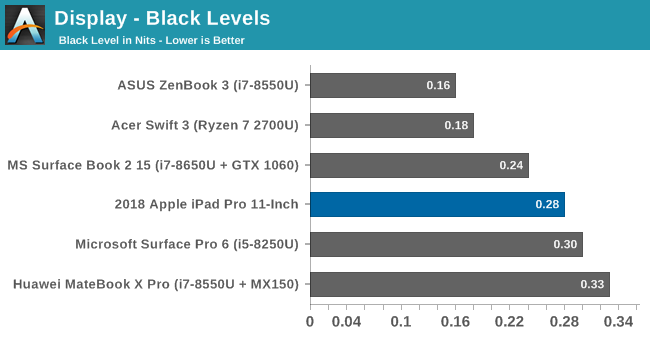
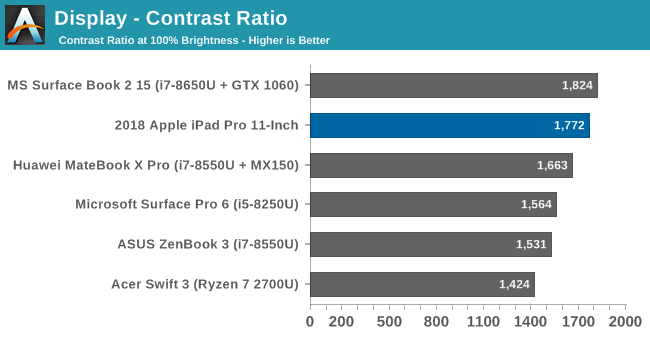
Under our test conditions the iPad Pro could not quite hit the 600 nits that Apple advertises, but at 500 nits it is still plenty bright. Couple that with the excellent contrast ratio of almost 1800:1, and things are off to a good start.
Grayscale
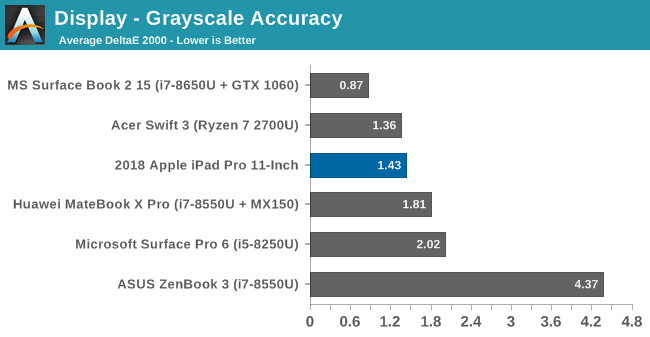
The average dE2000 of 1.43 is a fantastic result, but the gamma isn’t quite perfect, dropping off near 100% because the display was slightly too bright. Unfortunately, the red results were quite low throughout the entire range leading to a slightly cooler display white point, but this is all quite minor.
Gamut
First let’s take a look at sRGB:

As you can see, the sRGB values are almost perfectly mapped into the P3 D65 gamut, and the average error level of just over 1.09 is simply fantastic. All of the primary and secondary values are close to perfect, except red which was a bit low at 100% red, as we saw in the grayscale results.
Next up, P3 D65:
As with the sRGB results, the P3 D65 gamut is also almost perfect. The beauty of color management means that there’s no work for the user to get the benefit of both P3 and sRGB.
Saturation

The saturation sweep was run in sRGB, and as you can see from the graphs, all along all of the primary and secondary colors the error level is basically imperceptible to the human eye.
Gretag Macbeth
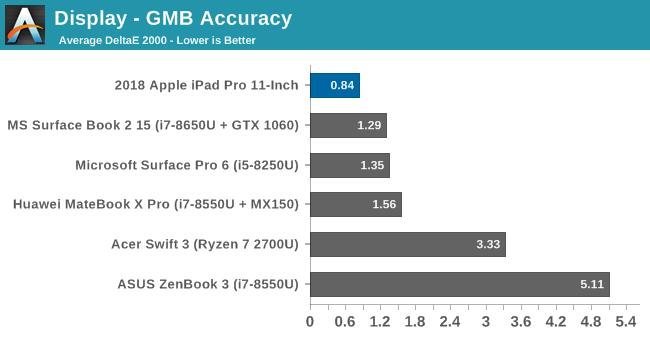
Finally, the Gretag Macbeth test is a more comprehensive test, hitting colors outside of the primary and secondary colors, including the important skin tones. The error level is practically perfect, with no single color even hitting an error level of 2.0.
Display Conclusion
The iPad Pro simply offers one of the best displays on any electronic device. Color accuracy is superb, in both the P3 and sRGB gamuts, and thanks to iOS supporting full color management, customers don’t have to worry about if they are working on a P3 or sRGB image. The addition of True Tone makes for an incredibly pleasing white point in pretty much any situation, and the 120 Hz display refresh rate makes for smooth scrolling, while stepping down to lower refresh rates to conserve power when the display is static.


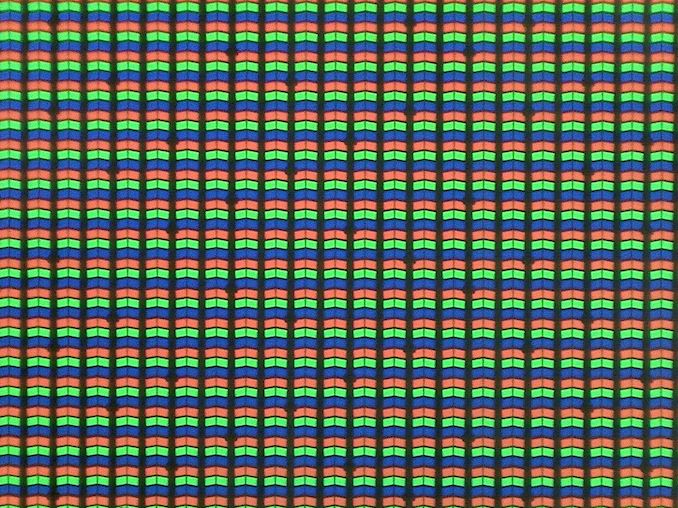


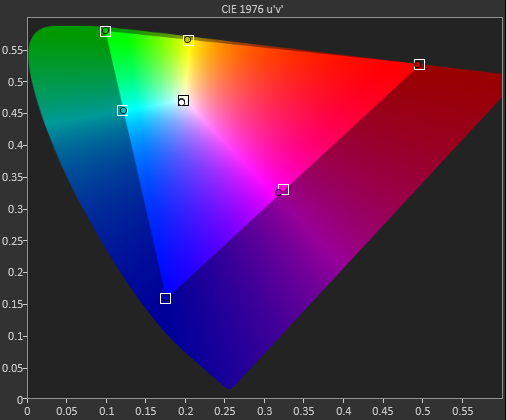










145 Comments
View All Comments
blackcrayon - Wednesday, December 5, 2018 - link
That's where the app store comes in - it would make sense to ban any apps that didn't work with just the touchscreen. That would make a lot more sense than what they originally did with the Apple TV and gaming controllers...blackcrayon - Wednesday, December 5, 2018 - link
It absolutely is a "toggle" - at least for basic functionality - the iOS Simulator has been around for a decade and is a "mouse driven iOS" after all...nico_mach - Tuesday, December 4, 2018 - link
For $800, they should move as fast as an A12x. It should be multi-user and have basic file management features, even if only for external storage.ex2bot - Tuesday, December 4, 2018 - link
Not that this really affects the good points you make, but GoodReader does a very nice job accessing SMB and other shares.markiz - Wednesday, December 5, 2018 - link
100+Lezmaka - Tuesday, December 4, 2018 - link
How much storage does the iPad you tested have? Was it 1TB meaning 2GB extra RAM? If so, since most people won't be getting that version, how does that affect performance or battery life (if at all)Ryan Smith - Tuesday, December 4, 2018 - link
It's the 1TB model. So yes, it has an extra 2GB of RAM. Not that it would make a difference in a device this large. The screen is the single biggest power consumer by a large margin, followed by the SoC.As for performance, it's more difficult to say since we don't have a 4GB model. It shouldn't be impacted much, but throw enough large applications at it and you might trigger something.
melgross - Tuesday, December 4, 2018 - link
Adobe demo’d photoshop on the 1TB 12.0’ model using a 3GB file with hundreds of live layers, and the speed popped. The amount of RAM doesn’t seem to be an issue here. I would have liked to see tests of the storage subsystem to see the speeds there.vFunct - Tuesday, December 4, 2018 - link
Isn't the extra RAM on the 1TB model used purely for disk caching?tipoo - Tuesday, December 4, 2018 - link
Any source for that?